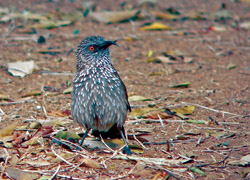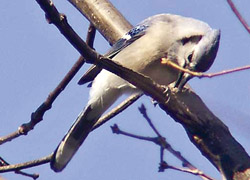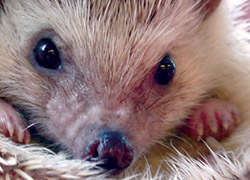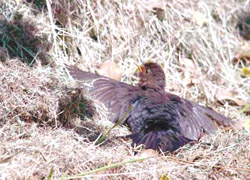Nature Trail
Strange animal behaviour:
Bathing with ants, smoke and fire!
A mystifying behavioural phenomenon (occurrence) which has been
observed mostly among birds that continues to baffle (puzzle) scientists
is Ďanting.í
It is a ritual Ďbathingí using ants, smoke and fire, undertaken
mostly by birds. But recently, other animals too have been observed
doing it. As to why they do it is a hotly debated topic.
|

A babbler - During direct anting, the bird picks up a live ant
and rubs it under its wings. |
|

A different ant is used for each wing |
|

Hedgehogs too resort to self anointing |
|

During indirect anting the bird usually sits near a colony of
ants extending its wings |
|

Usually it starts Ďantingí its left wing first |
|

Some birds are almost addicted to anting |
During anting, birds will either allow the ants to crawl all over
their bodies or take ants and rub them against their skin.
It has been observed by researchers that more than 250 species of
birds, a majority of which are passerines (perching birds) take to
anting. The other birds practising anting on record are various
gallinaceous species such as pheasants and turkeys. Even parrots,
woodpeckers and the great horned owl do it.
Birds are reported to derive visible pleasure from this strange
process of anting which can be divided into two major categories -
direct anting and indirect anting. Direct anting is the commonest form
practised. It is most frequently observed among babblers, starlings,
tanagers and weaver birds.
So, what is direct anting? It is when a bird picks up a live ant with
its beak and wipes it under the flight feathers on each of its extended
wings. Usually it starts Ďantingí its left wing first and devotes more
time on it than to the right wing.
Why it concentrates so much on the left wing is yet to be discovered.
Whatís more interesting is that a different ant is used for each wing;
the old one is either eaten or discarded before picking a new ant.
During anting, the birds have been observed to quiver and shake.
Researchers believe they derive great pleasure when the ants secrete
(discharge) formic acid against their skin. It has been noted that while
some birds are almost addicted to anting, others in the same species
hardly ever perform this ritual. This too is something that has no
explanation.
We know what happens during direct anting, so letís find out how
indirect anting, which is also known as ant bathing, is done.
During indirect anting recorded mostly among crows (especially jays),
thrushes and wax bills, the bird usually sits near a colony of ants
extending its wings into a throng of these insects so that they could
crawl up its wings, body and head. In this instance too the bird visibly
trembles and shivers, as if in pleasure.
What are the types of ants birds use for this purpose? Are there any
special species, you may wonder. Well, so far, researchers have
documented at least 25 different types of ants used by the birds.
Occasionally other insects have also been used.
As we explained earlier, scientists and nature researchers are unable
to explain why birds and even other animals resort to anting. Many
theories have been put forward, but none has been universally accepted
so far.
According to one theory, the birds practise anting to get rid of the
ectoparasites from their skin with the help of the insecticidal
properties of the formic acid released by the ants.
Some say it is done to find solace from the pain induced by the
growth and replacement of feathers. Yet others say it is done to tone
its feathers, but then some ask as to why so much attention is paid to
the left wing when anting? Another theory put forward is that anting is
done purely for its sensation.
Some even claim it is done to remove the unpleasant liquids from the
antís body before making a meal of it. Now, what do you think could be
accepted out of all these various theories put forward by the experts?
Donít you think that whatever the reason may be, it certainly is strange
behaviour?
Remember we said birds also bathe in smoke and fire? Sounds even more
bizarre, doesnít it? Letís check this out as well...
Smoke-bathing, the researchers say is very much similar in effect and
appearance to anting - the only difference being that the birds use
smoke instead of ants.
Now how do they smoke-bathe? Most commonly, you could see one or more
crows or starlings perched at the top of a chimney that is belching (emiting
or releasing) out smoke.
The birds usually stay perched on top of the chimney with their wings
extended over the smoke, quivering in the same manner as when bathing
with ants or Ďantingí. They are sometimes seen even trying to pluck a
plume of smoke out of the cloud of smoke coming out of the chimney, to
place under each wing.
Researchers say that even during smoke bathing, birds are known to
pay more attention to their left wing than the right one.
More dramatic than either of the above mentioned methods of bathing
is fire-bathing. You would be amazed to learn that during fire-bathing,
a bird actually extends its wings over burning straw or some other form
of fire. The birds deftly (skilfully) avoid getting burnt. Why the birds
perform this ritual, especially with fire is yet unclear.
As it has been recently observed, itís not only birds that practise
anting. Other species too resort to this. Self anointing which is
performed by hedgehogs is believed to be the mammalian equivalent to
anting.
Where hedgehogs and self-anointing are concerned, they donít use
ants. When the hedgehog encounters an object with a strong odour, it
continually licks it until it has built up a sizable amount of saliva in
its mouth.
Then, it throws its head on to a side, twists its body and uses its
tongue to place the saliva froth onto its back or its flank. This
procedure is repeated several times until it has coated much of its
spiny body in saliva. Like with anting, this process could last 20
minutes or more.
The hedgehog too has been observed to be in a state of ecstasy like
the birds, when self-anointing.
Like with anting, the explanations put forward are similar, but in
the case of hedgehogs, some experts say this self-anointing may be done
to fool potential predators by disguising its natural body odour. The
reason this theory has been put forward is because, hedgehogs have been
observed resorting to self-anointing only during the breeding season.
Apart from hedgehogs, lemurs too have been observed indulging in
Ďanting - sometimes using millipedes. The millipede is first bitten and
then rubbed on its fur perhaps, with the aim of using the secretions
from the wounded millipede as protection against parasites. More
recently, reptiles, especially turtles too have been seen anting. |
